Uncle Willy's Goggomobil Actually, I never was a super motivated old timer fan. This was supposed to change when my father asked me: Do you want an old car and fix it up?
Actually, I never was a super motivated old timer fan. This was supposed to change when my father asked me: Do you want an old car and fix it up?
I replied: No, thanks, I prefer to let the owner fix his scrap himself. He: Too bad, Uncle Willy would certainly be pleased if someone would take care for his Goggomobil.
The Goggomobil meant the world to Uncle Willy. As a house painter it served him as his company vehicle. With the front passenger seat removed he carted around paint buckets and ladders.
Uncle Willy was the cousin of my grandma and I knew his Goggomobil from childhood, since it is four years older than I am.
A few days later we went to see him and his Goggomobil.
TUV (safety inspection) was still valid and it also started right up without any problems. No surprise, since it got in the eighties one of those rebuilt engines out of Bremen.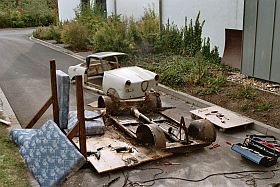 The body, however, was in poor condition. We noticed how much the Goggo was dear to Uncle Willy's heart and I assured him do my utmost to bring it back to a good condition. Since a garage to perform the restoration was available we took the Goggomobil right with us.
The body, however, was in poor condition. We noticed how much the Goggo was dear to Uncle Willy's heart and I assured him do my utmost to bring it back to a good condition. Since a garage to perform the restoration was available we took the Goggomobil right with us.
After I rolled a few yards downhill, my heart beat suddenly increased when I hit the brakes. I was able to build briefly up some pressure - but then the pedal went through to the floor. With a pulled handbrake I just barely came to a stop just before entering a busy highway. With wobbly knees, I drove slowly to the garage. The restoration began in August of 1998. First step was to remove the body from the floor pan. In the hollows under the seats it was as if the Goggo has had seven lives, - no I meant plates, which were welded, one on top of the other which looked like an armored shield. At this point I was ready to through in the towel. No, with so much rust, a restoration probably would not make sense. I asked a friend who had restored vintage cars, and his advice was: they all look like this, order some replacement parts first and then start. Once the parts are purchased you're committed and simply have to continue with the restoration and after a while the joy will come back.
First step was to remove the body from the floor pan. In the hollows under the seats it was as if the Goggo has had seven lives, - no I meant plates, which were welded, one on top of the other which looked like an armored shield. At this point I was ready to through in the towel. No, with so much rust, a restoration probably would not make sense. I asked a friend who had restored vintage cars, and his advice was: they all look like this, order some replacement parts first and then start. Once the parts are purchased you're committed and simply have to continue with the restoration and after a while the joy will come back.
I followed this advice and got myself, with the help of the GLAS club, addresses of part suppliers.
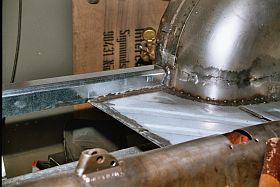
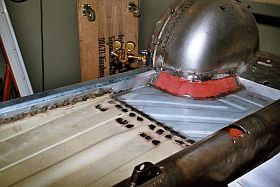
After I had everything together, it started with the body work. The doors and the sheet metal under the seats were new original spare parts (thanks to Mr. Köster). Doors, wheel arches and end plates were fitted, welded and tinned. The body was removed from the floor again and painted on the inside. After that they were married once again, and this time they remain together for the preparation work such as spackling, sanding and priming of the body. After this step was done the car was painted.
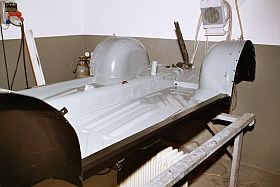

All work, such as sandblasting, welding and painting were done by me in my garage. The paint shows very little dust inclusions and the gloss is OK. The bumpers were sanded and painted silver. (The rear bumper has three license plate lights.)
The original rubber flooring existed only in pieces therefore I replaced it with cut and fitted carpet covering which was shaped in some areas with a heat gun. Since the original head liner was no longer there, a new head liner was installed. The front seats were taken from a BMW Goggo parts car and the rear bench seat was recovered by an upholstery shop.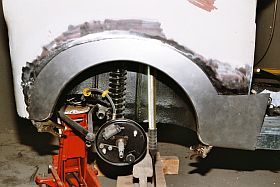 For sure, this is not a first class museum piece, but that was also not planned. The restoration was completed in March of 1999 and the next TUV appointment was coming up in April 1999.
For sure, this is not a first class museum piece, but that was also not planned. The restoration was completed in March of 1999 and the next TUV appointment was coming up in April 1999.
This Goggomobil will certainly be one of the few Goggos that was always registered. The current mileage is 85,865 km. And every year a few miles are added from small tours in the Schmallenberger Sauerland. The Goggomobil still fascinates young and old and steals the show away from many much more expensive cars. During a classic car meet in 1999 an enthusiastic fan (himself a former Goggo Coupe owner) was so taken in that he put 10 Euro in my hand and said: For that you can buy some decent oil.
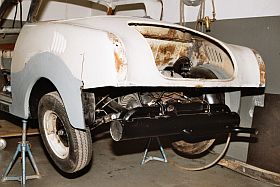
 Unlike today's vehicles, this small Goggo according to the instructions, requires much more maintenance.
Unlike today's vehicles, this small Goggo according to the instructions, requires much more maintenance.
Small maintenance service: every 2500 km, large Service: every 5000 km, large extended maintenance service: every 10,000 km.
Last spring, I was convinced of the power this twin, two-stroke GLAS engine had. Progressing rapidly, taking advantage of the last few Newton meters of torque, I suddenly took my foot off the gas pedal when I saw a flash. They say in a Goggo you cannot be flashed? Well, in a 30 zone you can! I will never forget the grinning face on the officer.
Heiner Schauerte




